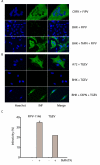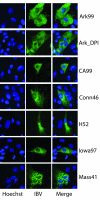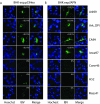Feline aminopeptidase N is not a functional receptor for avian infectious bronchitis virus
- PMID: 17324273
- PMCID: PMC1810517
- DOI: 10.1186/1743-422X-4-20
Feline aminopeptidase N is not a functional receptor for avian infectious bronchitis virus
Abstract
Background: Coronaviruses are an important cause of infectious diseases in humans, including severe acute respiratory syndrome (SARS), and have the continued potential for emergence from animal species. A major factor in the host range of a coronavirus is its receptor utilization on host cells. In many cases, coronavirus-receptor interactions are well understood. However, a notable exception is the receptor utilization by group 3 coronaviruses, including avian infectious bronchitis virus (IBV). Feline aminopeptidase N (fAPN) serves as a functional receptor for most group 1 coronaviruses including feline infectious peritonitis virus (FIPV), canine coronavirus, transmissible gastroenteritis virus (TGEV), and human coronavirus 229E (HCoV-229E). A recent report has also suggested a role for fAPN during IBV entry (Miguel B, Pharr GT, Wang C: The role of feline aminopeptidase N as a receptor for infectious bronchitis virus. Brief review. Arch Virol 2002, 147:2047-2056.
Results: Here we show that, whereas both transient transfection and constitutive expression of fAPN on BHK-21 cells can rescue FIPV and TGEV infection in non-permissive BHK cells, fAPN expression does not rescue infection by the prototype IBV strain Mass41. To account for the previous suggestion that fAPN could serve as an IBV receptor, we show that feline cells can be infected with the prototype strain of IBV (Mass 41), but with low susceptibility compared to primary chick kidney cells. We also show that BHK-21 cells are slightly susceptible to certain IBV strains, including Ark99, Ark_DPI, CA99, and Iowa97 (<0.01% efficiency), but this level of infection is not increased by fAPN expression.
Conclusion: We conclude that fAPN is not a functional receptor for IBV, the identity of which is currently under investigation.
Figures






References
-
- Spaan WJM, Brian D, Cavanagh D, de Groot RJ, Enjuanes L, Gorbalenya AE, Holmes KV, Masters PS, Rottier PJ, Taguchi F, Talbot P. Virus Taxonomy: Family Coronaviridae. In: Fauquet CM, Mayo MA, Maniloff J, Desselberg U, Ball LA, editor. Eighth Report of the International Committee on Taxonomy of Viruses. 8th. London , Elsevier Academic Press; 2005. pp. 947–964.
-
- Vijgen L, Keyaerts E, Moes E, Thoelen I, Wollants E, Lemey P, Vandamme AM, Van Ranst M. Complete genomic sequence of human coronavirus OC43: molecular clock analysis suggests a relatively recent zoonotic coronavirus transmission event. J Virol. 2005;79:1595–1604. doi: 10.1128/JVI.79.3.1595-1604.2005. - DOI - PMC - PubMed
Publication types
MeSH terms
Substances
Grants and funding
LinkOut - more resources
Full Text Sources
Research Materials
Miscellaneous

